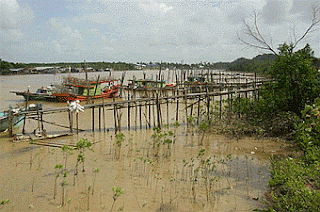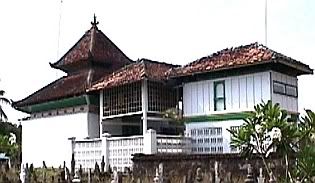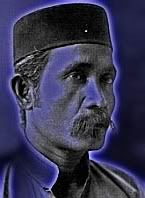The Bell and a Stick
The man with the white turban wrapped around his red hat was our Mufti Sheikh Yusuf al-Zawawi, Egyptian and engaging, a man who was at ease with everybody and was widely respected for his presence and learning, and he leant on his walking stick as he looked around in the Tanjong market.
I don't suppose the Mufti of Trengganu in the present day goes to town anymore with his driver by his side and his handbasket of fish and fruit, but Sheikh Yusuf with thobe flowing and driver in tow looked at the array of fish laid out on the mat on the floor in the market and pointed at it with his stick. The fish seller, unmindful of the office of the mufti and the prospective customer in the flowing robe, grabbed hold of the stick and cast it unceremoniously aside.
This was a story I was told by many an elderly folk to illustrate the gap between foreign practicalities and Trengganu's delicate form and etiquette. Even the man of religion was liable to make grave mistakes when it came to what we in Trengganu called jjuruh, and its cousins tertib terning and tamakninöh. The irony is tamakninöh came from the Arabic tuma'nina meaning composure or calmness as in prayer, but in Trengganuspeak it has taken on the extended meaning of 'being prim and proper'. Someone who's lacking in it, i.e. takdök tamakninöh goes about hurriedly and waves his stick about, though I hasten to add that our Mufti wasn't a man who was intentionally rude. He was just not totally immersed in our local ways.
"Biar gök tamakninöh sikik wok! Tertib terning gök sikik!" is a reproach from an elder to a very young person (wok) to be mindful and polite and right. Tertib is, as you've recognised, from another Arabic word, tartib, order. Tertib terning is what I've called in the past, a ding-dong word. [see, Friends in the Night, infra;Growing Up In Trengganu, supra]. A tertib person knows the order of things and has the savoir faire that's born of good breeding, so his opposite would be löklak, a word I've also heard used in Kedah. Mat Löklak burns the bread, trips on the cat, walks in front of elders without stooping down low and wears his songkok with the edges aligned with his shoulder blades.
Here's the ultimate disapprobation for someone whose form is totally bad and manners absolutely out: "Dök jjuruh haröh setabok harang!" In other words, a way beyond redemption sort of folk.
Now our Sheikh Yusuf al-Zawawi once shook his stick at the Bukit Putri and silenced the genta bell that'd been tolling for a good many years on the Hill of our Princess; and so it was that the bell was heard no more in the Ramadhan months and on the eve and morn of our Eids (Hari Raya) after that. His reason for silencing the bell-chimes that brightened our festive months was because it was un-Islamic he said (and he could well have been right). For years Kuala Trengganuers felt the loss and mourned the silence and the emptiness of our genta-less Eids; but happily for them they still had the sonorous voice of Bilal Sa'id and the thunderous tones of Bilal Deramang that came down from the minarets from dawn to dusk to fill the emptiness in their hearts.
The voices of Pak Sa'id and Pak Deramang (Abdul Rahman) have long gone into the ethers of Hari Rayas past, and the genta is now perhaps forever silenced by the al-Zawawi stick, but I wish my Muslim readers a happy Hari Raya nevertheless: may your day be as sweet as the call of the takbir on this blessed 'Eid.
Labels: Eid, Genta, Lebai Deramang, Lebai Sa'id, Sheikh Yusuf al-Zawawi






